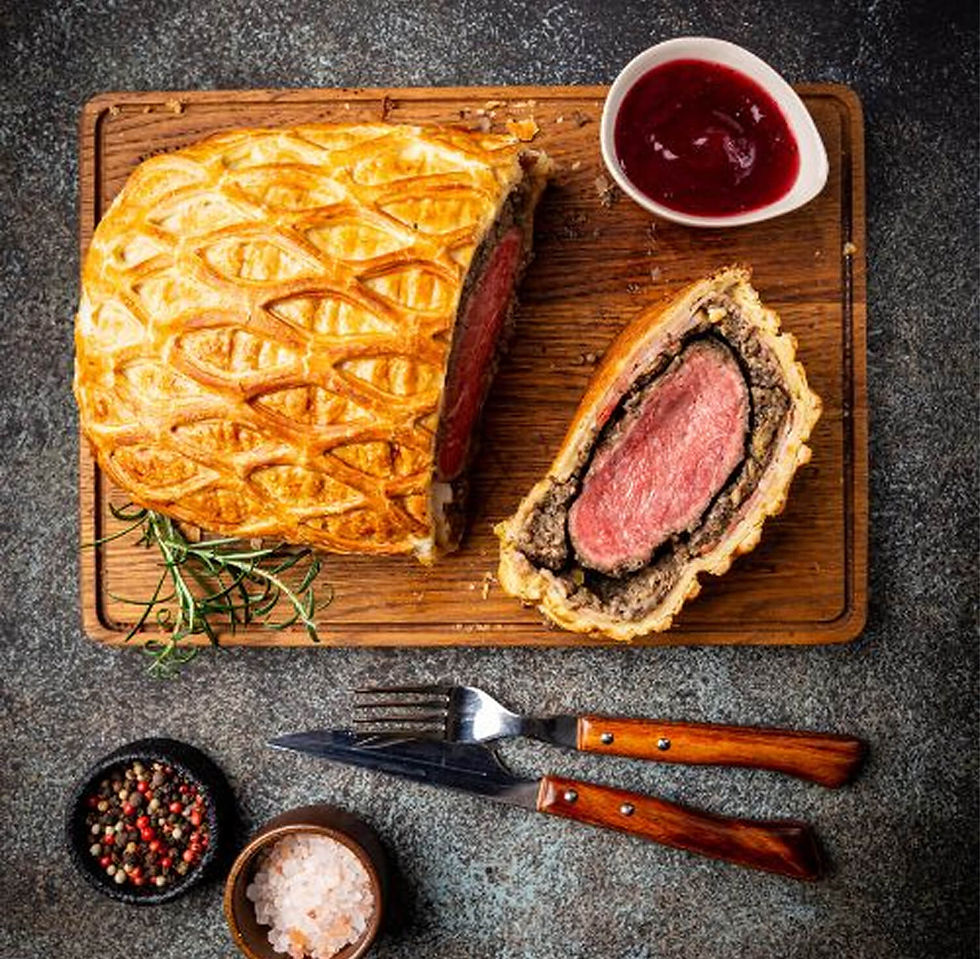Prosciutto-Wrapped Chicken with a Basil Pesto Ricotta Stuffing in a Sage-Butter Sauce
- Aug 25, 2023
- 3 min read

Looking for an easy, delicious weeknight dinner? Try my Prosciutto-Wrapped Chicken Breasts. I stuff my chicken breasts with basil pesto and ricotta cheese. I like making pesto this time of year because the basil in my herb garden is at its peak. If you are in a real rush or don’t grow basil, you can use prepared pesto from the supermarket.
This recipe calls for two slices of prosciutto per chicken breast. If you have your prosciutto sliced at the deli, ask the clerk to separate each piece with paper. This keeps the slices from sticking together.
Don’t cut the breasts open to see if they are cooked through, the stuffing will run out. To determine if the chicken has reached an internal temperature of 160 degrees F, insert a meat thermometer into the thickest part of the breast.
I make a sage butter sauce to serve with my chicken breasts. If you are in a real rush to get dinner on the table, you can heat up some marinara sauce, but the sage butter sauce is delicious.
Prosciutto-Wrapped Chicken with a Basil Pesto Ricotta Stuffing and a Sage Butter Sauce Makes 4 Servings
For the pesto:
2 cups fresh basil leaves ¼ cup pine nuts 3 teaspoons minced garlic ½ cup grated Parmesan cheese ½ cup extra virgin olive oil Salt to taste Freshly ground black pepper to taste
In a food processor, combine basil, pine nuts, garlic, cheese, and olive oil. Pulse until blended. Season to taste with salt and pepper. For the stuffing:
1 pound (16-ounces) ricotta cheese Basil Pesto Salt to taste Freshly ground black pepper to taste
In a medium bowl, place ricotta cheese. Add basil pesto and fold gently. Season to taste with salt and pepper.
For the chicken:
4 boneless, skinless chicken breasts 8 slices prosciutto Salt to taste Freshly ground black pepper to taste Extra virgin olive oil
Preheat the oven to 400 degrees F. Using a sharp knife, cut into and across but not all the way through the chicken breasts, so that they open up like a book. Spoon one fourth of the pesto ricotta stuffing into each breast. Fold chicken breasts back over stuffing and wrap each breast with two slices of prosciutto, carefully covering the whole breast. Brush chicken with olive oil and season to taste with salt and pepper.
Place 1 tablespoon of olive oil in an ovenproof sauté pan over a high heat on the stove top. When oil sizzles, sear breasts on the seam side of prosciutto. Using a spatula, turn the breasts and sear the other side. Place the pan in the oven and roast for 15 to 20 minutes, or until cooked through. Cooking time varies depending upon the thickness of the breasts. Chicken should be cooked to an internal temperature of 160 degrees F. Once chicken is cooked, transfer to a plate and cover loosely with aluminum foil. Let rest for 5 to 8 minutes before serving. For the sage butter sauce:
½ cup chicken broth 3 tablespoons butter 1 teaspoon minced garlic 1 tablespoon fresh sage, finely chopped Crushed red pepper flakes, to taste ¼ cup dry white wine
Transfer the ovenproof sauté pan to the stove top and place over a medium low heat. Add chicken broth and stir, scrapping the bottom of the pan, to incorporate any pan dripping. Add butter, garlic, sage, and crushed red pepper and sauté for 5 minutes, stirring occasionally, or until the sage turns crispy. Add wine and simmer for 3 more minutes. Remove from the heat. Slice chicken breasts and spoon the sage butter sauce evenly over the chicken breasts.
Tips on shopping for fresh herbs: When shopping for fresh herbs, select ones with even green color and no signs of wilting, yellowing, or insect damage. Fresh herbs should be washed before using. After washing, pat dry with paper towels. To help prolong the life of some herbs, place them in a glass of water, stems down, cover with a reusable, eco-friendly produce storage bag or a plastic bag, secure the glass with a rubber band, and refrigerate. Change the water every 2 days. This works nicely with basil, cilantro, mint, and parsley. Fresh herbs lose their flavor if you cook them too long, so they should be added towards the end of cooking.
Carol Ann
Carol Ann Kates is the award-winning author of cookbook, Secret Recipes from the Corner Market and Insider Grocery Shopping Secrets. She’s an expert in how to shop, select, and store produce for maximizing home cooking outcomes and minimizing time and money spent. As a former supermarket and deli operator, Carol Ann shares grocery-insider wisdom—the same expertise you used to receive when patronizing a mom-and-pop establishment. Contact her at CarolAnn@CarolAnnKates.com and explore her website, www.CarolAnnKates.com.
Copyright 2023 All Rights Reserved Carol Ann Kates
1
Searing the Beef
Sear beef fillets on high heat for 2 minutes per side to form a golden crust. Let it cool before proceeding to keep the beef tender.
1
Searing the Beef
Sear beef fillets on high heat for 2 minutes per side to form a golden crust. Let it cool before proceeding to keep the beef tender.
1
Searing the Beef
Sear beef fillets on high heat for 2 minutes per side to form a golden crust. Let it cool before proceeding to keep the beef tender.
1
Searing the Beef
Sear beef fillets on high heat for 2 minutes per side to form a golden crust. Let it cool before proceeding to keep the beef tender.
Notes



1
Season the good fresh beef fillets with salt and black pepper. Heat olive oil in a pan over high heat and sear the fillets for 2 minutes per side until it fully browned. Remove the beef from the pan and brush with a thin layer of mustard. Let it cool.



1
Season the good fresh beef fillets with salt and black pepper. Heat olive oil in a pan over high heat and sear the fillets for 2 minutes per side until it fully browned. Remove the beef from the pan and brush with a thin layer of mustard. Let it cool.



1
Season the good fresh beef fillets with salt and black pepper. Heat olive oil in a pan over high heat and sear the fillets for 2 minutes per side until it fully browned. Remove the beef from the pan and brush with a thin layer of mustard. Let it cool.



1
Season the good fresh beef fillets with salt and black pepper. Heat olive oil in a pan over high heat and sear the fillets for 2 minutes per side until it fully browned. Remove the beef from the pan and brush with a thin layer of mustard. Let it cool.
Instructions
Quality Fresh 2 beef fillets ( approximately 14 ounces each )
Quality Fresh 2 beef fillets ( approximately 14 ounces each )
Quality Fresh 2 beef fillets ( approximately 14 ounces each )
Beef Wellington

Beef Wellington
Fusion Wizard - Rooftop Eatery in Tokyo
Author Name

Beef Wellington is a luxurious dish featuring tender beef fillet coated with a flavorful mushroom duxelles and wrapped in a golden, flaky puff pastry. Perfect for special occasions, this recipe combines rich flavors and impressive presentation, making it the ultimate centerpiece for any celebration.
Servings :
4 Servings
Calories:
813 calories / Serve
Prep Time
30 mins
Prep Time
30 mins
Prep Time
30 mins
Prep Time
30 mins










Comments